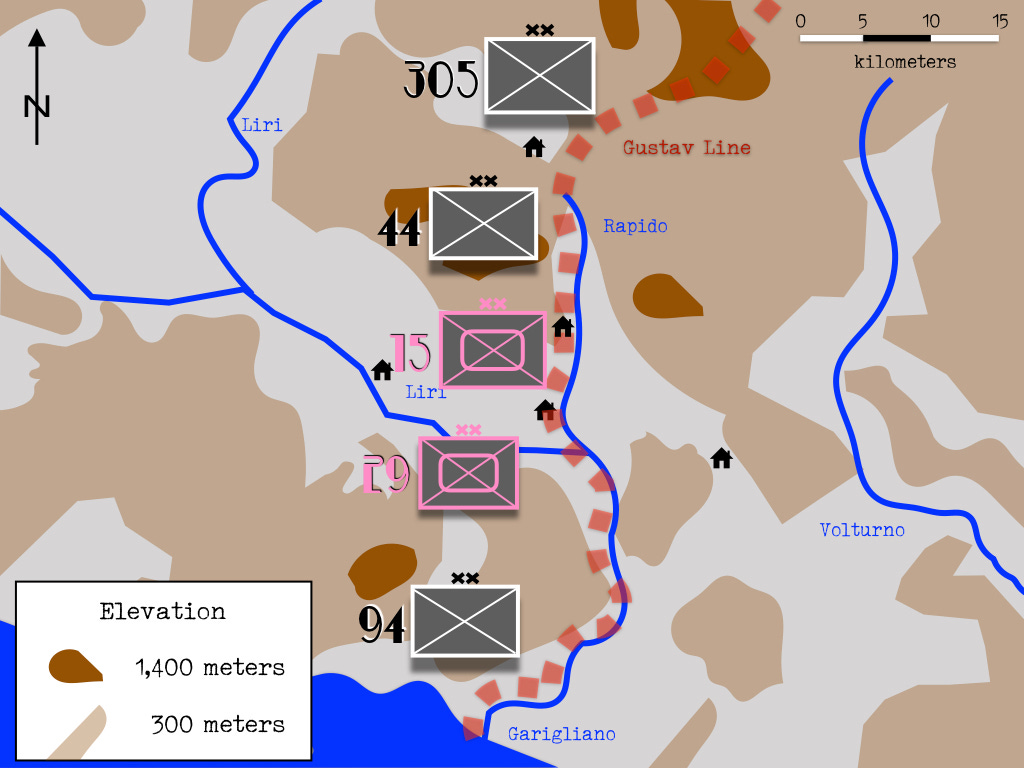The following is a verbatim translation of an order was issued by the senior artillery officer of the XIV Panzer Corps on the eve of the long battle for Monte Cassino.
Artillery Commander (Motorized) 414 , Artillery Order Number 4, 2 December 1943
1.) Everything must be done to the preserve the fighting power of the artillery for the likelihood of a large-scale attack. Command posts must be changed frequently. Dummy positions of all kinds must be built. (Don’t forget to employ artillery simulators in the paths leading out of these dummy positions! Piles of earth, smoking chimneys, and the like.) As a rule, use roving guns [Arbeitsgeschützen] to carry out fire missions.
2.) Make sure that your batteries are making full use of their ability to traverse.
3.) Revenge Fire. Every time the enemy brings heavy fire to bear upon one of our positions the enemy artillery in question must be fired upon by every available tube in the neighborhood. To this end, several “revenge fire zones” have been established in the areas where enemy “artillery nests” are concentrated. These are to be subjected to revenge fire as rapidly as possible. Therefore, revenge fire must be requested in a timely fashion. On a daily basis, the Artillery Commander will change the particular targets within these zones in a way that reflects the activity of enemy artillery. The Artillery Commander will give the order for revenge fire. Example: “Revenge fire on Casilina in fifteen minutes. Attention! The time is now ____! Ammunition: one standard amount! (Thus, to continue the example, 7/29 will fire on Target 509, 6./HG on Target 517, the 1/557 on 514, and 3/764 on 511.)1
4.) For the sake of fire direction, every time an enemy battery is fired upon, the coordinates of the target (minus adjustments made to allow for the influence of weather) is to be reported to the Artillery Commander.
5.) Every daily report should indicate the times when the enemy artillery fires little and those when it fires a lot.
6.) Shortage of ammunition. In view of the extraordinarily difficult supply situation Commanding officers are asked to exercise extremely close supervision over the use of ammunition.
7.) Storage of ammunition. The military situation no longer permits the improvement of storage facilities for ammunition. In order to do a better job of protecting ammunition from the weather, and, above all, from enemy fire, stacks of ammunition resting on planks or posts should be kept dry: surrounded on all side by a wall made of earth and stones and protected from the rain by a removable grating that has been covered with tar paper. Attention must be paid to the runoff of rain water.
8.) Camouflage. The falling of the leaves and the resulting reduction in natural concealment requires a review of measures taken to hide our positions, followed by the immediate correction of any deficiencies in camouflage.
9.) Recently, a regrettable incident took place in a village that was under enemy observation. For the sake of their education, a senior non-commissioned officer (Feldwebel) forbade the men of a replacement company to seek cover during an enemy bombardment. Two direct hits killed or wounded nearly all members of that company. Like all other units, the Corps Artillery must immediately post signs indicating places that are under enemy observation. When such places are within range of enemy artillery, all gatherings are strictly forbidden.
10.) Experience teaches us that the recoil absorbers and recuperators of artillery pieces are particularly vulnerable to enemy fire. Sometimes, a single little shell fragment has kept us from using an artillery piece for a long time. In order to protect against this, cover the recoil absorbers and recuperators with wooden slats with a thickness of three to five centimeters. These do not weigh much, but will catch some of the shell fragments.
11.) The shortage of telephone cables requires us to be especially thrifty. No delivery of new cables is expected at any point in the foreseeable future.
Signed,
Alexander von Grundherr
Colonel and Artillery Commander
PS: I have the impression that observers are not as active as they should be and thus must do a better job of paying attention. Significant events were not reported in a timely manner or even recognized as such. I ask battalion and battery commanders to pay particular attention to this matter. Sharp observation and timely reporting are as important as good shooting!
The batteries were actual units serving on Monte Cassino at the time the order was issued. They were the 7th Battery of the 29th Field Artillery Regiment, the 6th Battery of the Herman Goering Field Artillery Regiment, the 1st Battery of the 514th Field Artillery Regiment, and the 3rd Battery of the 764th Field Artillery Regiment.





These standing orders to the artillery would equally apply in the current conflict to Ukraine / Russia in the
Grundherr
Ground-Army
DuGotzaluvensiederDeutschersprechen